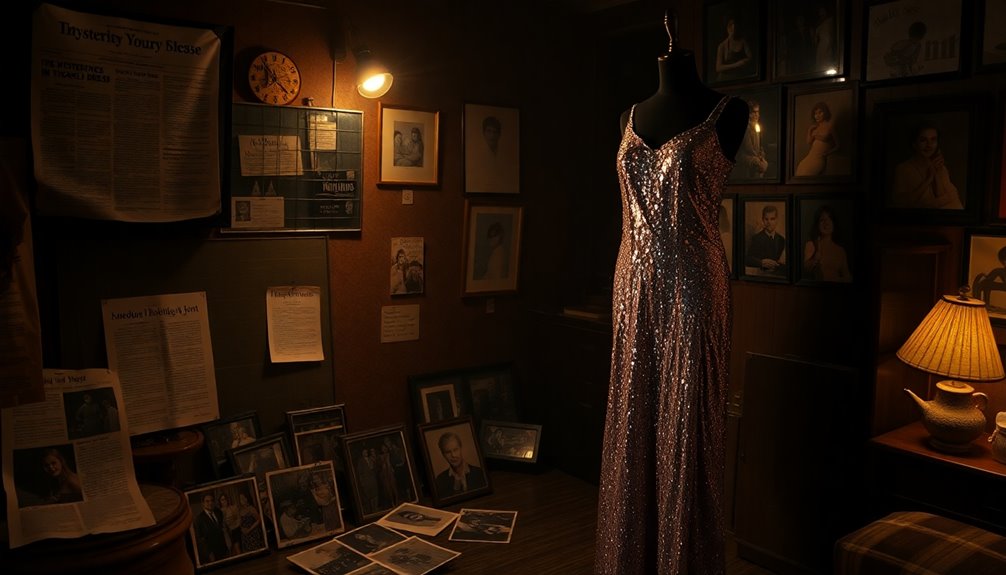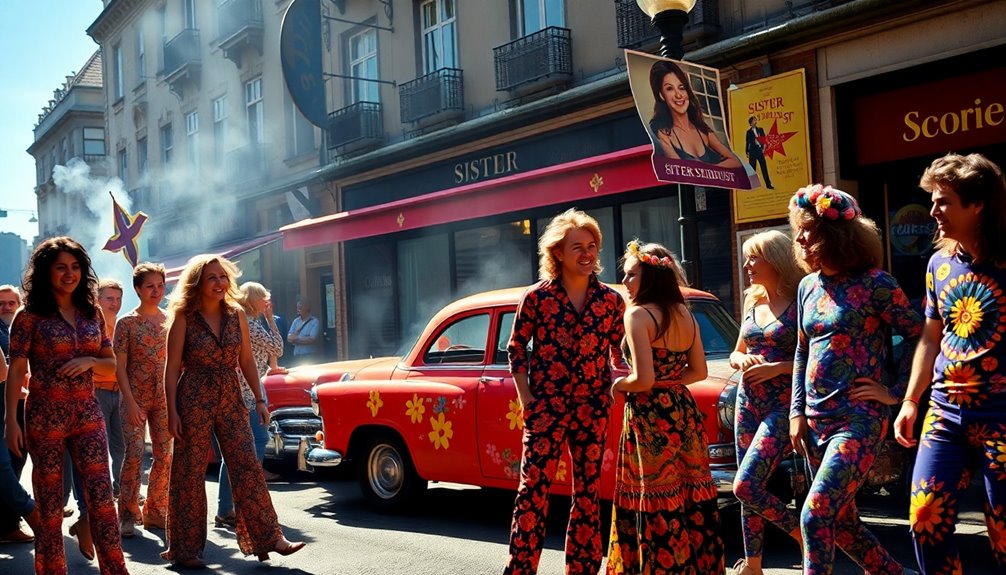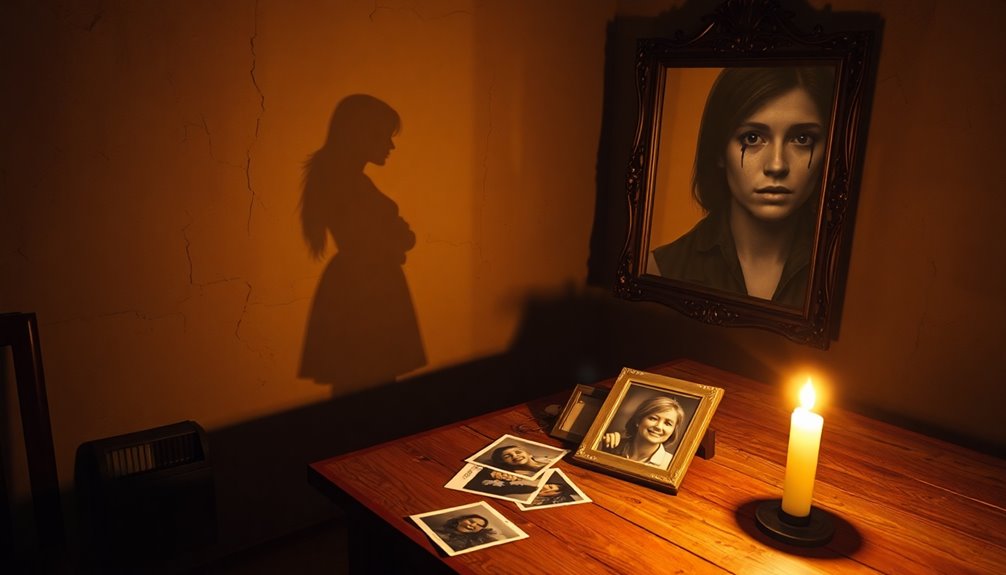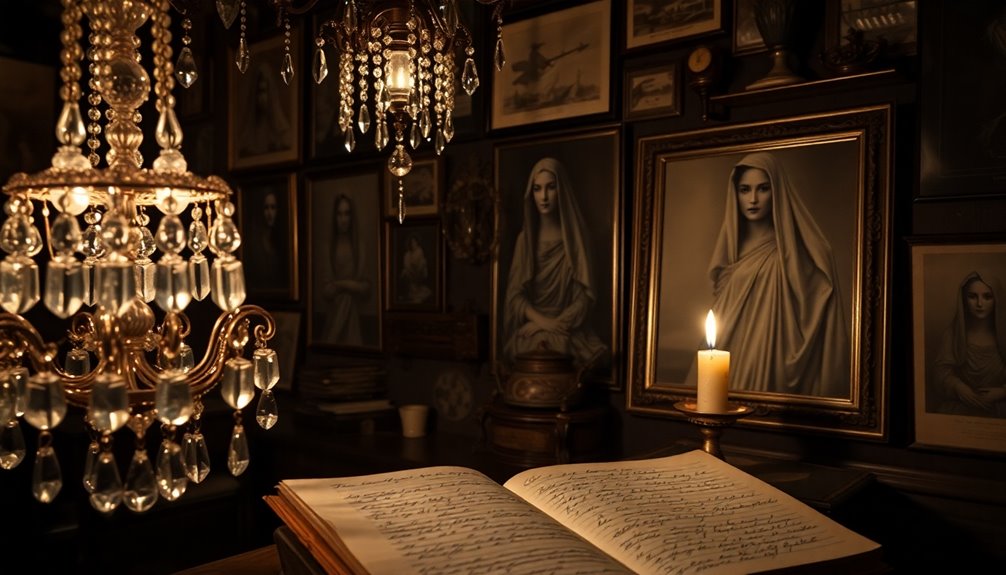Yes, "Sister Stardust" is based on real events, drawing inspiration from the life of Talitha Getty, a fashion icon of the 1960s. The novel explores her glamorous yet turbulent lifestyle, highlighting themes of friendship, trauma, and healing against the backdrop of the Swinging Sixties. Author Jane Green immerses you in the vibrant culture of the era, revealing the seductive and destructive nature of Talitha's experiences. Discover the intricacies of her story and how it unfolds.
The Inspiration Behind Sister Stardust

"Sister Stardust" draws you into the enchanting world of Talitha Getty, a fashion icon whose glamorous 1960s lifestyle serves as the backbone of the story.
Jane Green masterfully weaves a narrative inspired by the true story of Talitha, exploring her magnetic allure and the darker shadows of her life, such as addiction and early trauma. This complexity mirrors the emotional turmoil and moral dilemmas faced by characters in other narratives, such as *The Thorn Birds*.
You'll find yourself captivated by Claire, a fictionalized character seeking adventure and transformation against the backdrop of Talitha's vibrant existence. The themes of healing and empowerment resonate throughout the story, reflecting the strength needed to overcome personal struggles.
Green's extensive research brings historical accuracy to the forefront, blending real events and figures from the era into the rich tapestry of this historical fiction.
In doing so, "Sister Stardust" provides a compelling glimpse into a glamorous lifestyle marked by both beauty and struggle. The exploration of generational poverty echoes the universal themes of resilience found in other narratives of immigrant experiences. The intertwined lives and sacrifices in *The Thorn Birds* further illustrate the profound impact of family dynamics on individual identity and choices.
Who Was Talitha Getty?
You might be intrigued by Talitha Getty's journey from her early life in Java to becoming a fashion icon in 1960s London. Her bohemian lifestyle and connections to the counterculture movement shaped her legacy, making her a symbol of a vibrant era. Additionally, her life echoes themes of empowerment and betrayal similar to those found in historical mysteries like "The Lost Apothecary." Notably, her story reflects the resilience of women who navigated societal challenges in a transformative period, adding depth to her impact on society. Furthermore, her narrative resonates with the struggles against systemic oppression that many faced during this transformative period, adding layers to her complex legacy. However, her story is also marked by personal struggles that add depth to her impact on society.
Early Life Influences
Although many know Talitha Getty for her glamorous role in the 1960s fashion scene, her early life was marked by profound challenges that shaped her identity. Born in Java in 1940, she endured trauma as a child during her internment in a Japanese camp during World War II. This experience impacted her mental health and later struggles with addiction.
As an iconic fashion model, she became known for her bohemian lifestyle, often attending lavish parties alongside her husband, Paul Getty, an heir to the Getty oil fortune. While she dazzled in the socialite circle, her life reflected the darker side of that glamorous lifestyle.
Talitha Getty remains a real-life figure whose complexities continue to inspire cultural narratives, such as "Sister Stardust."
Bohemian Lifestyle in London
Emerging from a childhood marked by trauma, Talitha Getty embraced a bohemian lifestyle that defined her years in London during the 1960s.
As the wife of oil heir Paul Getty, she became a prominent socialite, known for hosting glamorous parties that attracted musicians and artists, embodying the counterculture of the era.
These extravagant gatherings often included drug use, showcasing the allure and dangers of her lifestyle.
Despite her charm and fashion sense, Talitha struggled with addiction and mental health issues, which cast a shadow over her glamorous existence.
Her enchanting presence and connections made her an "It Girl," yet the darker side of her life ultimately contributed to her tragic early death, revealing the complexities of her bohemian world.
Legacy and Impact
The legacy of Talitha Getty resonates as a poignant reminder of the interplay between glamour and tragedy in the world of 1960s London.
As a socialite and troubled icon, she embodied the hedonistic spirit of the era, mingling with celebrities and artists at lavish parties in Marrakesh. Born into privilege, with a wealthy oil magnate as a father and married to Paul Getty, Talitha's glamorous life masked deep-seated struggles.
Her childhood trauma in a Japanese internment camp left scars, influencing her tumultuous world. Despite her vibrant presence, struggles with drug abuse and mental health issues led to her tragic death at just 30.
Talitha Getty's impact remains, symbolizing the complexities of fame and excess that continue to fascinate.
Claire's Journey and Its Historical Context
As Claire initiates her transformative journey from a small town to the vibrant cultural scene of 1960s London, you can feel the pulse of the era's quest for freedom and self-discovery.
Her evolution into Cece mirrors the dynamic counterculture surrounding her, marked by:
- The electrifying energy of rock & roll nights
- The intoxicating allure of high-fashion gatherings
- The shadowy complexities of fame and excess
Amidst this historical context, Claire's friendships, especially with Talitha Getty, deepen her understanding of the glamorous yet tumultuous lifestyle. This period resonates with the class struggles faced by many, reflective of a broader societal narrative. The resilience and hope demonstrated by individuals navigating these challenges underscore the transformative power of personal connections.
Her journey takes a pivotal turn as she travels to Marrakesh, where the contrasts between excitement and personal challenges become stark. This exploration captures the essence of a decade defined by bold transformations and societal shifts, reflecting the ongoing fight for gender equality and women's rights that characterized the period.
The Swinging Sixties: A Cultural Revolution

The Swinging Sixties transformed society in ways you might find fascinating.
As music evolved with bands like The Beatles and The Rolling Stones, it mirrored a shift in fashion and identity expression that defined a generation. This era also saw the rise of classic space opera, providing a rich backdrop for storytelling that reflected the cultural zeitgeist. During this time, epic quests in literature captivated readers, allowing them to escape into captivating realms of adventure.
This era's embrace of counterculture challenged norms and sparked movements that still resonate today. Additionally, the influence of genre diversity in literature during this time contributed to the cultural revolution, shaping how stories were told and received.
Cultural Shifts and Trends
While exploring the cultural landscape of the Swinging Sixties, you'll discover a vibrant revolution that transformed London into the epicenter of youth culture.
This era embraced hedonism and defied social norms, fostering a dynamic counterculture that reshaped society.
You'll find:
- Iconic musicians like The Beatles and The Rolling Stones, whose music became the soundtrack of a generation.
- Fashion innovations, including the miniskirt popularized by designer Mary Quant, symbolizing liberation.
- A backdrop of civil rights movements and anti-war protests, highlighting the era's societal tensions.
As you investigate further, you'll see how this cultural revolution not only celebrated excess but also challenged traditional values, leaving an indelible mark on future generations.
Music and Counterculture Influence
Amidst the vibrant upheaval of the Swinging Sixties, music emerged as a powerful force driving counterculture movements. You can see how icons like The Beatles and The Rolling Stones redefined sound, challenging social norms and inspiring liberation.
Talitha Getty embodied this spirit, living a life intertwined with the music and hedonism of the era. The decade fostered a sexual revolution, pushing boundaries around relationships and gender roles.
As you explore the influence of Sister Stardust, you'll notice how the counterculture sought peace, love, and communal living through artistic expression. The experimentation with drugs and alternative lifestyles mirrored the allure and darker sides of the time, offering a glimpse into a world transformed by music and a quest for freedom.
Fashion and Identity Expression
Fashion during the Swinging Sixties transformed how people expressed their identities, reflecting a cultural revolution that celebrated individuality and freedom. This era was marked by bold choices that challenged norms and embraced liberation.
You'd see:
- Vibrant miniskirts and go-go boots that turned heads.
- Geometric patterns splashed across the streets, symbolizing a break from tradition.
- Musicians like Twiggy and David Bowie blurring gender lines through their unique styles.
As the counterculture movement flourished, music and fashion intertwined, allowing you to embrace your true self.
The Beatles and The Rolling Stones not only influenced fashion trends but also became icons of rebellion, encouraging you to express your identity openly.
The Swinging Sixties truly reshaped the landscape of fashion and identity expression.
Exploring Themes of Friendship and Trauma

As Claire and Talitha's friendship unfolds in "Sister Stardust," it becomes clear that their bond is rooted in shared trauma and a longing for connection.
Their relationship reflects a transformative experience, showcasing how the intensity of their emotional vulnerability deepens amidst the chaotic backdrop of the 1960s. This emotional journey highlights the importance of creative expression as a means to process their trauma and find healing. The healing process can be likened to the acts of courage displayed by individuals in historical resistance movements, where personal struggles are met with resilience and determination.
Claire and Talitha discover solace in each other, maneuvering a hedonistic lifestyle filled with glamour and turbulence.
This passionate friendship mirrors love affairs, as they lean on one another to cope with the absence of maternal love and the scars of their pasts.
Ultimately, "Sister Stardust" highlights the seductive yet destructive nature of friendships shaped by trauma, emphasizing the profound need for support in a world that often feels overwhelming. In times of hardship, acts of defiance can foster deep connections and resilience.
Real-Life Figures Interwoven in the Narrative
While diving into "Sister Stardust," you'll find that real-life figures play a crucial role in shaping the narrative. The story revolves around Talitha Getty, a fashion icon whose glamorous lifestyle in the 1960s offers a vivid backdrop.
Imagine:
- Lavish parties filled with the sounds of the 1960s music scene.
- Deep conversations about dreams and despair between Claire and Talitha.
- The haunting shadows of drug addiction that challenge their friendship.
Jane Green's extensive research brings authenticity to these characters, capturing the essence of Talitha's troubled life.
As you explore their connection, you'll appreciate how real-life figures enrich the tale, highlighting both the allure and complexities of friendship amidst the turbulence of that era.
The Glamorous Yet Dark Side of the 1960s
Though the 1960s are often celebrated for their vibrant cultural shifts and glamorous icons, this era also harbored a darker underbelly that often goes unnoticed.
Talitha Getty, a symbol of this duality, epitomized the luxurious yet tumultuous lifestyle of the time. The rock & roll scene dazzled with fame, yet it masked a reality filled with excess and addiction.
Friendships forged in the chaos often crumbled under the weight of emotional struggles, highlighting the complexities of life in that era.
Behind the allure of fashion and music, the dark side of the 1960s reveals a poignant truth: even the most glamorous lives can be riddled with trauma, painting a stark picture of the hidden battles many faced.
Research and Creative Process of Jane Green
To accurately portray Talitha Getty in "Sister Stardust," Jane Green immersed herself in extensive research, diving into books and personal accounts that revealed the complexities of Getty's life.
She engaged in conversations with former lovers and friends, capturing the essence of 1960s culture and the intricacies of female friendships.
- Vibrant parties filled with laughter and music
- Heartfelt stories of love and loss
- The glamorous yet tumultuous lifestyle of icons
Through her creative process, Green blended fictional storytelling with historical accuracy, reflecting themes of trauma and connection between the main characters, Claire and Talitha.
This meticulous approach enriched the narrative, allowing readers to experience a fascinating glimpse into both the allure and challenges of that era.
Comparing Fiction With Historical Accuracy
As you explore "Sister Stardust," you'll notice how Jane Green skillfully weaves fiction with historical accuracy, creating a narrative that feels both engaging and authentic.
The story, inspired by Talitha Getty's glamorous lifestyle during the 1960s, captures the essence of the swinging sixties in London and Marrakesh.
While Green incorporates fictional elements to enhance the narrative, she's also grounded in reality, reflecting the cultural revolution of the time.
The character Claire represents the many young women seeking adventure and independence.
However, some readers argue that the novel doesn't investigate deeply into Getty's struggles until later, which may impact its overall historical accuracy.
Despite this, the blend of fact and fiction keeps the reader captivated throughout.
Reader Reactions to the Historical Aspects of the Novel
How do readers feel about the historical aspects of "Sister Stardust"? Many appreciate the vivid portrayal of the swinging 60s, especially the glamorous lifestyle surrounding Talitha Getty. This fascination often leads readers to explore her life further.
You might picture:
- The vibrant streets of London, alive with color and music.
- Marrakech's exotic allure, where dreams and reality blur.
- The darker aspects of excess, revealing a shadowy underbelly beneath the glam.
While some critiques argue the narrative romanticizes this lifestyle, others value its exploration of adventure and tragedy.
Reader reactions vary, igniting discussions about the authenticity of experiences and relationships within the historical context, making "Sister Stardust" an enchanting blend of fact and fiction.
Conclusion
To sum up, "Sister Stardust" whirls you through a dazzling kaleidoscope of the 1960s, where the glitz of fame clashed spectacularly with the shadows of trauma. You'll find yourself tumbling down a neon-lit rabbit hole of friendship, heartbreak, and the haunting echoes of history. As you close the book, the vibrant colors of Talitha Getty's life will dance in your mind, leaving you breathless, exhilarated, and craving the bittersweet magic of an era that was both enchanting and tragic.



